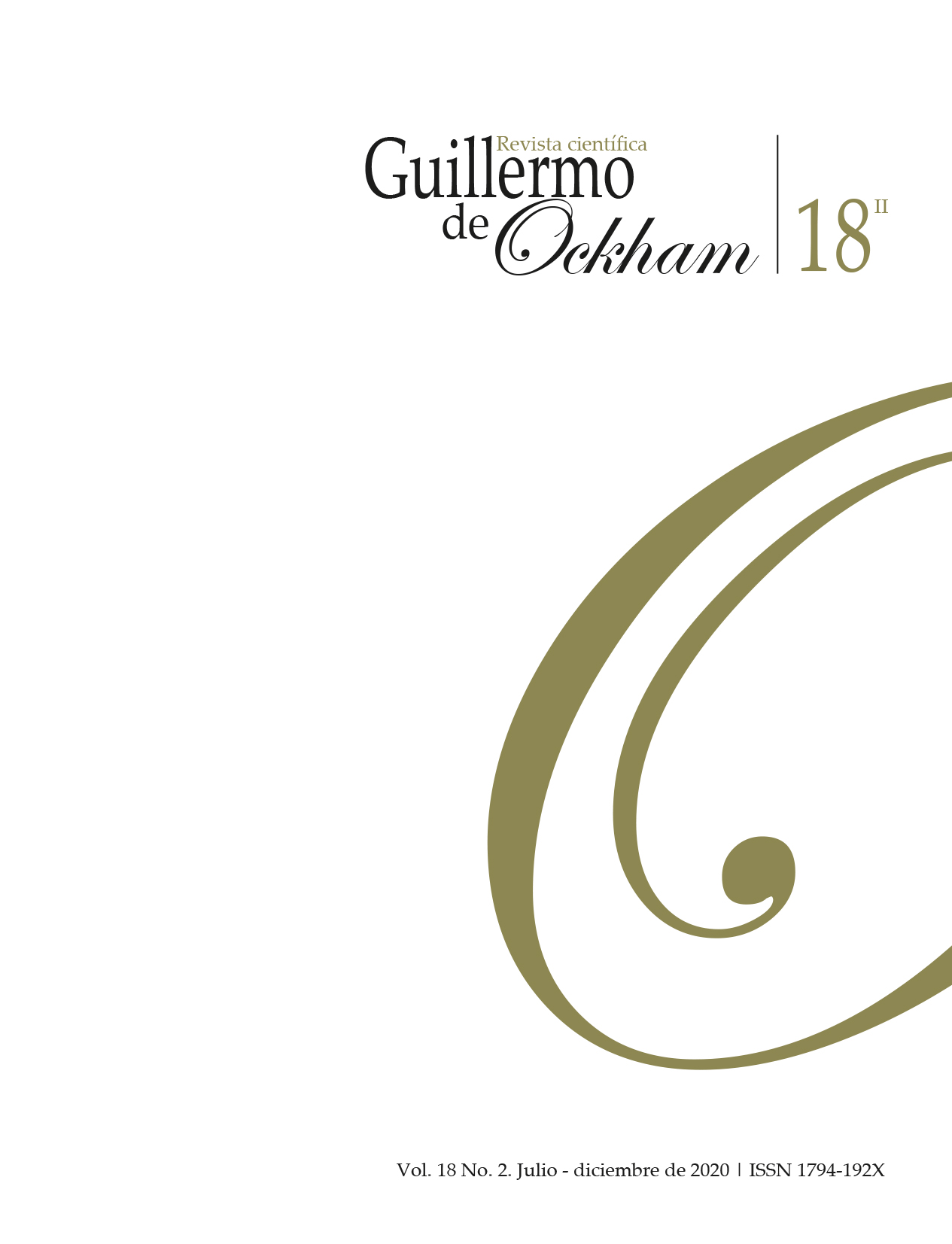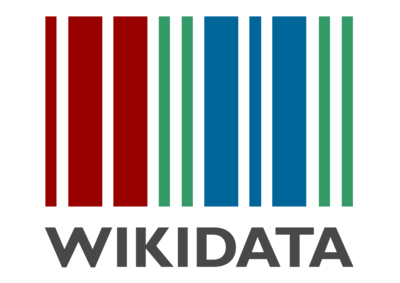The Revista Guillermo de Ockham provides an immediate and open access to its content, based on the principle of offering the public a free access to investigations to provide a global interchange of knowledge.
Unless otherwise established, the contents of this journal has a license with Creative Commons Attribution-NonCommercial-NoDerivatives 4.0 International (CC BY-NC-ND 4.0) http://creativecommons.org/licenses/by-nc-nd/4.0/
- Attribution: You must give appropriate credit, provide a link to the license, and indicate if changes were made. You may do so in any reasonable manner, but not in any way that suggests the licensor endorses you or your use.
- NonCommercial: You may not use the material for commercial purposes.
- NoDerivatives: If you remix, transform, or build upon the material, you may not distribute the modified material.
- No additional restrictions: You may not apply legal terms or technological measures that legally restrict others from doing anything the license permits.
Abstract
Political advertising has become a field of high interest to social scientists over time. The purpose of this document is to analyze the literature developed around the subject, identifying the growth trend over time, relevant authors, regions where the concept has been studied, fundamental characteristics of political advertising, and finally, future lines of research. The research uses a bibliometric analysis of 295 manuscripts extracted from Web of Science. The results suggest that the field of political advertising has been growing in the last five years. However, in Latin America, academic production is scarce. It is evident that the topics of greatest interest have revolved around the role that political advertising plays in promoting candidates and parties, the effects of the announcements on the electorate and the influence of aggressive or negative advertising.
References
Ansolabehere, S. D., Iyangar, S., & Simon, A. (1999). Replicating Experiments Using Aggregate and Survey Data: The Case of Negative Advertising and Turnout. American Political Science Review (Vol. 93). https://doi.org/10.2307/2586120
Barba, B. (2003). Los indicadores bibliométricos: fundamentos y aplicación al análisis de la ciencia. Asturias: Trea Ed.
Benoit, W. L. (2000). A functional analysis of political advertising across media, 1998. Communication Studies, 51(3), 274–295.
Benoit, W.L. & Klyukovski, A.A. (2006). A functional analysis of the 2004 Ukrainian debates. En: Argumentation, Vol. 20, p. 209-225.
Berelson, B. R., Lazarsfeld, P. F., McPhee, W. N., & McPhee, W. N. (1954). Voting: A study of opinion formation in a presidential campaign. University of Chicago Press.
Bordons, M., & Zulueta, M. . (1999). Evaluación de la actividad científica a través de indicadores bibliométricos. Revista Española de Cardiología, 52(10), 790–800. https://doi.org/https://doi.org/10.1016/S0300-8932(99)75008-6
Bouyssou, D., & Marchant, T. P. 801001379881 0000-0002-2893-2964. (2011). Bibliometric rankings of journals based on impact factors: an axiomatic approach. (2011) JOURNAL OF INFORMETRICS. Retrieved from http://lib.ugent.be/catalog/pug01:1101733
Brader, T. (2005). Striking a Responsive Chord: How Political Ads Motivate and Persuade Voters by Appealing to Emotions. American Journal of Political Science, 49(2), 388–405. https://doi.org/10.1111/j.0092-5853.2005.00130.x
Brookes, B. C. (1969). Bradford’s law and the bibliography of science. Nature, 224(5223), 953.
Cadavid, L., Awad, G., & Franco, C. (2012). A bibliometric analysis of a modeled field for disseminating innovation. Estudios Gerenciales (Vol. 28).
Chaffee, S., & Choe, S. (1980). Time of Decision and Media Use During the Ford-Carter Campaign. Public Opinion Quarterly, 44(1), 53–69. https://doi.org/10.1086/268566
Cooper, H. (2015). Research synthesis and meta-analysis: A step-by-step approach (Vol. 2). Sage publications.
Durieux, V., & Gevenois, P. A. (2010). Bibliometric Indicators: Quality Measurements of Scientific Publication. Radiology, 255(2), 342–351. https://doi.org/10.1148/radiol.09090626
Evarts, D., & Guido, H. S. (1974). Coverage of the 1972 Campaign by TV, News Magazines and Major Newspapers. Journalism Quarterly, 51(4), 645–648. https://doi.org/10.1177/107769907405100409
Fowler, E. F., Franz, M., & Ridout, T. N. (2015). Political Advertising in 2012. Dataset]. Version, 1.
Fowler, E. F., & Ridout, T. N. (2009). Local television and newspaper coverage of political advertising. Political Communication, 26(2), 119–136.
Franz, M. M., & Ridout, T. N. (2007). Does political advertising persuade? Political Behavior, 29(4), 465–491.
Freedman, P., Franz, M., & Goldstein, K. (2004). Campaign advertising and democratic citizenship. American Journal of Political Science, 48(4), 723–741.
Freedman, P., & M. Goldstein, K. (1999). Measuring Media Exposure and the Effects of Negative Campaign Ads. American Journal of Political Science (Vol. 43). https://doi.org/10.2307/2991823
Gerber, A., Gimpel, J., Green, D., & Shaw, D. (2011). How Large and Long-lasting Are the Persuasive Effects of Televised Campaign Ads? Results from a Randomized Field Experiment. American Political Science Review (Vol. 105).
Goldstein, K., & Freedman, P. (2002). Campaign Advertising and Voter Turnout: New Evidence for a Stimulation Effect. The Journal of Politics, 64(3), 721–740. Retrieved from http://www.jstor.org/stable/1520110
Herman, E. S., & Chomsky, N. (2010). Manufacturing consent: The political economy of the mass media. Random House.
Herrero, J. C. & Benoit, W. L. (2009). Análisis funcional de los debates en las elecciones generales de 2008. ZER: Revista de Estudios de Comunicación= Komunikazio Ikasketen Aldizkaria, 14(27). Facultad de Ciencias Sociales y de la Comunicación de la Universidad del País Vasco/Euskal Herriko Unibertsitatea.
Kaid, L. (2002). Videostyle and political advertising effects in the 2000 presidential campaign. Westport, CT: Praeger.
Kaid, L. & Postelnicu, M. (2005). Political Advertising in the 2004 Election: Comparison of Traditional Television and Internet Messages. American Behavioral Scientist, 49(2), 265–278. Recuperado de: https://doi.org/10.1177/0002764205279421
Kaid, L., & Bacha, C. (2006). Television advertising and democratic systems around the world: A comparison of videostyle content and effects (pp. 445–458). https://doi.org/10.4135/9781412973403.n27
Kumar, A., & Pathak, P. (2013). Political advertising in India: a perspective. Management Insight, 8(1).
Larreguy, H. A., Snyder Jr, J. M., & Marshall, J. (2018). Leveling the playing field: How campaign advertising can help non-dominant parties. Journal of the European Economic Association, 16(6), 1812–1849. https://doi.org/10.1093/jeea/jvy001
Lotka, A. J. (1926). The frequency distribution of scientific productivity. Journal of the Washington Academy of Sciences, 16(12), 317–323.
Low, M. B., & MacMillan, I. C. (1988). Entrepreneurship: Past Research and Future Challenges. Journal of Management, 14(2), 139–161. https://doi.org/10.1177/014920638801400202
Martens, C. D. P., Lacerda, F. M., Belfort, A. C., & Freitas, H. M. R. de. (2016). Research on entrepreneurial orientation: current status and future agenda. International Journal of Entrepreneurial Behaviour and Research, 22(4), 556–583. https://doi.org/10.1108/IJEBR-08-2015-0183
Matthes, J., & Schmuck, D. (2015). The Effects of Anti-Immigrant Right-Wing Populist Ads on Implicit and Explicit Attitudes: A Moderated Mediation Model. Communication Research, 44(4), 556–581. https://doi.org/10.1177/0093650215577859
Noyons, E. C. M., Moed, H. F., & Luwel, M. (1999). Combining mapping and citation analysis for evaluative bibliometric purposes: A bibliometric study. Journal of the American Society for Information Science, 50(2), 115–131. https://doi.org/10.1002/(SICI)1097-4571(1999)50:2<115::AID-ASI3>3.0.CO;2-J
Okubo, Y. (1997). Bibliometric indicators and analysis of research systems.
Pinkleton, B. E., Um, N.-H., & Austin, E. W. (2002). An exploration of the effects of negative political advertising on political decision making. Journal of Advertising, 31(1), 13–25.
Pritchard, A. (1969). Statistical Bibliography or Bibliometrics? Journal of Documentation (Vol. 25).
Rey-Martí, A., Ribeiro-Soriano, D., & Palacios-Marqués, D. (2016). A bibliometric analysis of social entrepreneurship. Journal of Business Research, 69(5), 1651–1655. https://doi.org/10.1016/j.jbusres.2015.10.033
Sassmannshausen, S. P., & Volkmann, C. (2013). A bibliometric based review on social entrepreneurship and its establishment as a field of research. Schumpeter Discussion Papers.
Schildt, H. A., Zahra, S. A., & Sillanpää, A. (2006). Scholarly communities in entrepreneurship research: A co–citation analysis. Entrepreneurship Theory and Practice, 30(3), 399–415.
Schmuck, D., & Matthes, J. (2017). Effects of economic and symbolic threat appeals in right-wing populist advertising on anti-immigrant attitudes: The impact of textual and visual appeals. Political Communication, 34(4), 607–626.
Shah, D. V., Cho, J., Nah, S., Gotlieb, M. R., Hwang, H., Lee, N. J., … Mcleod, D. M. (2007). Campaign ads, online messaging, and participation: Extending the communication mediation model. Journal of Communication, 57(4), 676–703. https://doi.org/10.1111/j.1460-2466.2007.00363.x
Sohal, S. & Kaur, H. (2018). A Content Analysis of YouTube Political Advertisements: Evidence from Indian Parliamentary Elections. Journal of Creative Communications, 13(2), 133–156. Recuperado de: https://doi.org/10.1177/0973258618761408
Soley, L. C., & Reid, L. N. (1982). Promotional Expenditures in U.S. Congressional Elections. Journal of Marketing & Public Policy, 1(1), 147–155. https://doi.org/10.1177/074391568200100112
Spenkuch, J. L., & Toniatti, D. (2018). Political advertising and election results. Quarterly Journal of Economics, 133(4), 1981–2036. https://doi.org/10.1093/qje/qjy010
Valentino, N., Hutchings, V., & Williams, D. (2004). The Impact of Political Advertising on Knowledge, Internet Information Seeking, and Candidate Preference. Journal of Communication (Vol. 54). https://doi.org/10.1111/j.1460-2466.2004.tb02632.x
Van Eck, N. J., Raan, T., & Waltman, L. (2012). Waltman, L., N.J. van Eck, and A.F.J. van Raan (2012) Universality of Citation Distributions Revisited Journal of the American Society for Information Science and Technology 63(1) 72-77.
Van Steenburg, E. (2015). Areas of research in political advertising: A review and research agenda. International Journal of Advertising, 34(2), 195–231. https://doi.org/10.1080/02650487.2014.996194
Virgen Ortiz, V., Oliveros, C. E., & Betancourt Guerrero, B. (2014). Análisis bibliométrico del campo de formación de emprendedores . Cuadernos de Administración (Universidad Del Valle) . scieloco .
Williams, C. B., & Gulati, G. J. “Jeff. (2018). Digital Advertising Expenditures in the 2016 Presidential Election. Social Science Computer Review, 36(4), 406–421. https://doi.org/10.1177/0894439317726751

































